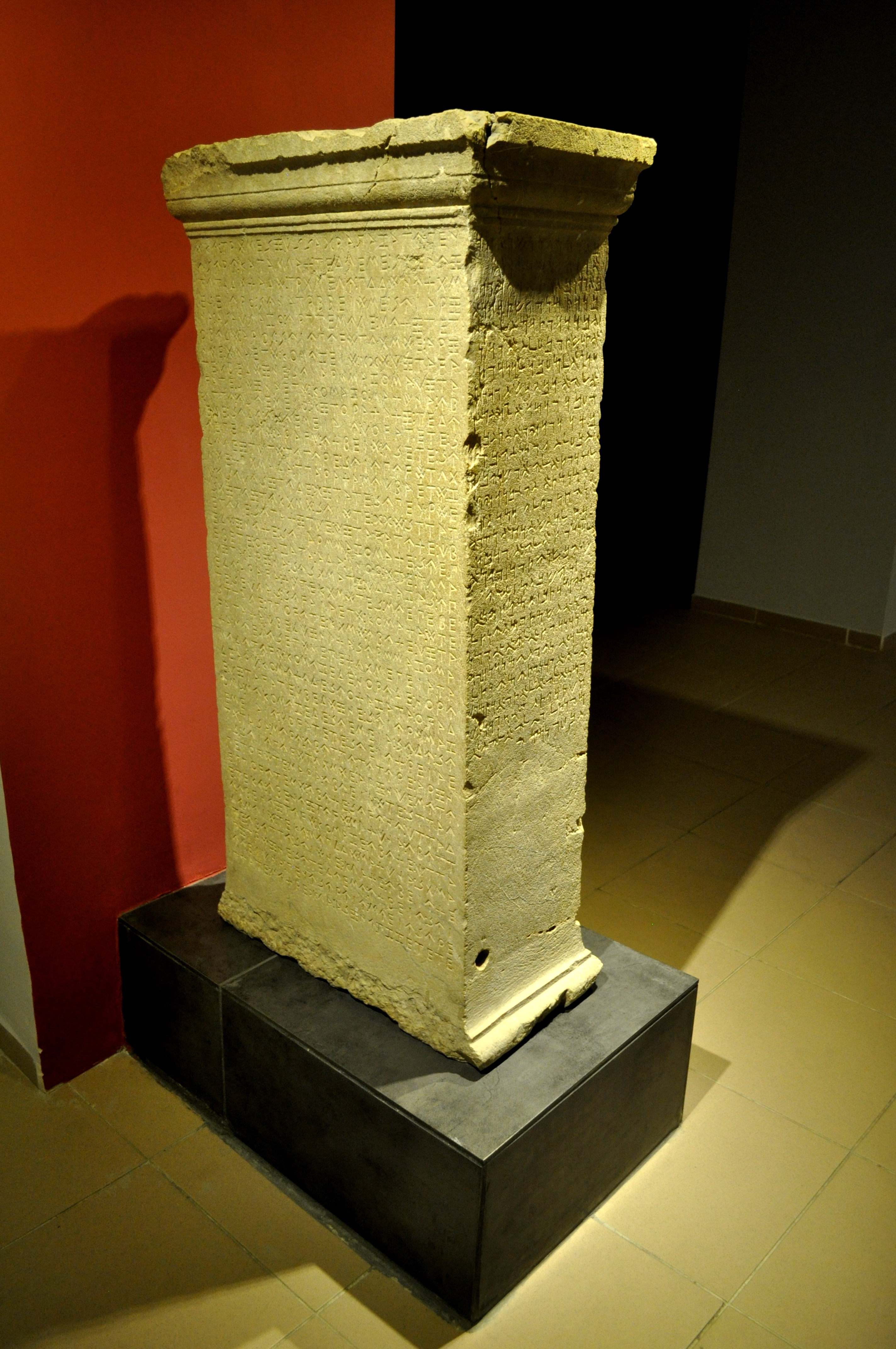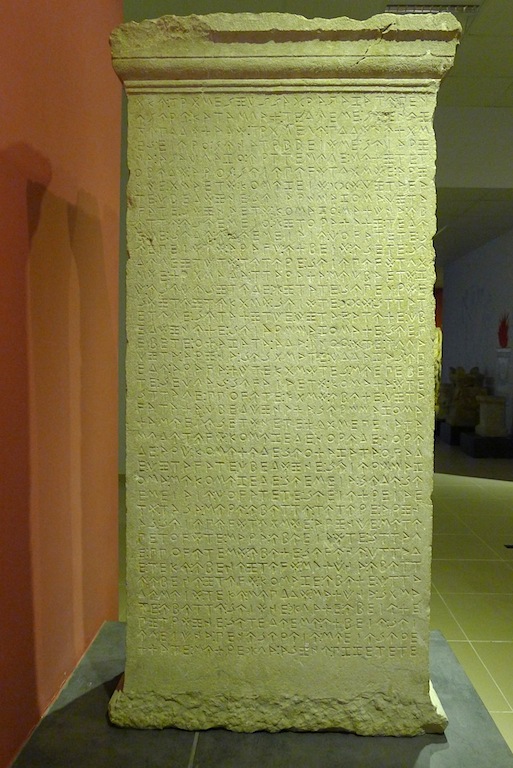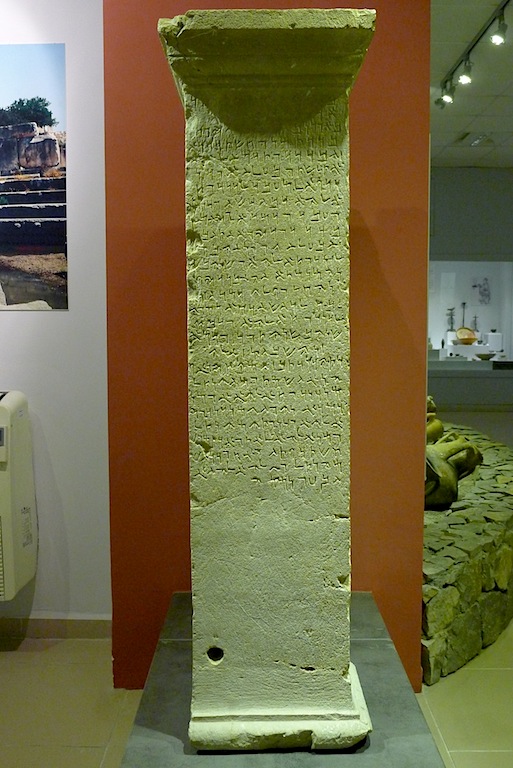Letoon trilingual on:
[Wikipedia]
[Google]
[Amazon]
 The Letoon trilingual, or Xanthos trilingual, is an inscription in three languages: standard Lycian or Lycian A,
The Letoon trilingual, or Xanthos trilingual, is an inscription in three languages: standard Lycian or Lycian A,
 The first five lines of the
The first five lines of the

 Below is a transliteration of a sample of lines with an English translation:
Below is a transliteration of a sample of lines with an English translation:
 The Letoon trilingual, or Xanthos trilingual, is an inscription in three languages: standard Lycian or Lycian A,
The Letoon trilingual, or Xanthos trilingual, is an inscription in three languages: standard Lycian or Lycian A, Greek
Greek may refer to:
Greece
Anything of, from, or related to Greece, a country in Southern Europe:
*Greeks, an ethnic group.
*Greek language, a branch of the Indo-European language family.
**Proto-Greek language, the assumed last common ancestor ...
, and Aramaic
The Aramaic languages, short Aramaic ( syc, ܐܪܡܝܐ, Arāmāyā; oar, 𐤀𐤓𐤌𐤉𐤀; arc, 𐡀𐡓𐡌𐡉𐡀; tmr, אֲרָמִית), are a language family containing many varieties (languages and dialects) that originated in ...
covering the faces of a four-sided stone stele called the Letoon Trilingual Stele, discovered in 1973 during the archeological exploration of the Letoon
The Letoon ( grc, Λητῷον), sometimes Latinized as Letoum, was a sanctuary of Leto located 4km south of the ancient city of Xanthos to which it was closely associated, and along the Xanthos River. It was one of the most important religi ...
temple complex (devoted to the goddess Leto
In ancient Greek mythology and religion, Leto (; grc-gre, Λητώ , ''Lētṓ'', or , ''Lātṓ'' in Doric Greek) is a goddess and the mother of Apollo, the god of music, and Artemis, the goddess of the hunt.Hesiod, ''Theogony'404–409/ref> ...
), near Xanthos
Xanthos ( Lycian: 𐊀𐊕𐊑𐊏𐊀 ''Arñna'', el, Ξάνθος, Latin: ''Xanthus'', Turkish: ''Ksantos'') was an ancient major city near present-day Kınık, Antalya Province, Turkey. The remains of Xanthos lie on a hill on the left b ...
, ancient Lycia
Lycia ( Lycian: 𐊗𐊕𐊐𐊎𐊆𐊖 ''Trm̃mis''; el, Λυκία, ; tr, Likya) was a state or nationality that flourished in Anatolia from 15–14th centuries BC (as Lukka) to 546 BC. It bordered the Mediterranean Sea in what is ...
, in present-day Turkey
Turkey ( tr, Türkiye ), officially the Republic of Türkiye ( tr, Türkiye Cumhuriyeti, links=no ), is a transcontinental country located mainly on the Anatolian Peninsula in Western Asia, with a small portion on the Balkan Peninsula in ...
. It was created when Lycia was under the sway of the Persian Achaemenid Empire
The Achaemenid Empire or Achaemenian Empire (; peo, 𐎧𐏁𐏂, , ), also called the First Persian Empire, was an ancient Iranian empire founded by Cyrus the Great in 550 BC. Based in Western Asia, it was the largest empire the world had ...
. The inscription is a public record of a decree authorizing the establishment of a cult, with references to the deities, and provisions for officers in the new cult. The Lycian requires 41 lines; the Greek, 35 and the Aramaic, 27. They are not word-for-word translations, but each contains some information not present in the others. The Aramaic is somewhat condensed. First page displayable no charge.
Although the use of the term "Letoon" with regard to the inscription and the stele is unequivocal, there is no standard name for either. Xanthos trilingual is sometimes used, which is to be distinguished from the Xanthos bilingual, meaning the Xanthos stele. However, sometimes Xanthos stele is used of the Letoon trilingual stele as well as for the tomb at Xanthos. Moreover, the term Xanthos trilingual (Lycian A, Lycian B, Greek) is sometimes used of the tomb at Xanthos. In the latter two cases only the context can provide clues as to which stele is meant. The Aramaic inscription is known as KAI 319.
Find site
The Lētōon was a temple complex about south ofXanthus Xanthus (; grc, Ξάνθος, ''Xanthos'', "yellow, blond") or Xanthos may refer to:
In Greek mythology
* Xanthos (King of Thebes), the son of Ptolemy, killed by Andropompus or Melanthus
*Xanthus (mythology), several figures, including gods, men, ...
, capital of ancient Lycia
Lycia ( Lycian: 𐊗𐊕𐊐𐊎𐊆𐊖 ''Trm̃mis''; el, Λυκία, ; tr, Likya) was a state or nationality that flourished in Anatolia from 15–14th centuries BC (as Lukka) to 546 BC. It bordered the Mediterranean Sea in what is ...
. The complex dates to as early as the 7th century BC and must have been a center for the Lycian League
Lycia ( Lycian: 𐊗𐊕𐊐𐊎𐊆𐊖 ''Trm̃mis''; el, Λυκία, ; tr, Likya) was a state or nationality that flourished in Anatolia from 15–14th centuries BC (as Lukka) to 546 BC. It bordered the Mediterranean Sea in what is t ...
. In it were three temples to Lētō, Artemis
In ancient Greek mythology and religion, Artemis (; grc-gre, Ἄρτεμις) is the goddess of the hunt, the wilderness, wild animals, nature, vegetation, childbirth, care of children, and chastity. She was heavily identified wit ...
and Apollō. The stele was found near the temple of Apollo. It has been removed to the museum at Fethiye
Fethiye () is a city and district of Muğla Province in the Aegean Region of Turkey. It is one of the prominent tourist destinations in the Turkish Riviera. In 2019 its population was 162,686.
History
Fethiye was formerly known as Makri (). ...
. The entire site is currently under several inches of water.
Date of the inscription
 The first five lines of the
The first five lines of the Aramaic
The Aramaic languages, short Aramaic ( syc, ܐܪܡܝܐ, Arāmāyā; oar, 𐤀𐤓𐤌𐤉𐤀; arc, 𐡀𐡓𐡌𐡉𐡀; tmr, אֲרָמִית), are a language family containing many varieties (languages and dialects) that originated in ...
version mention that the inscription was made in the first year of the reign of the Persian
Persian may refer to:
* People and things from Iran, historically called ''Persia'' in the English language
** Persians, the majority ethnic group in Iran, not to be conflated with the Iranic peoples
** Persian language, an Iranian language of the ...
king, Artaxerxes, but does not say which Artaxerxes:
In the month Siwan, year 1 of King Artaxerxes. In the fortress of Arñna (If the king in question was Artaxerxes III Ochus, the date of the inscription would be the first year of his reign, hence 358 BC. But Hecatomnus is thought to have ruled from ca. 395 to 377 BC andXanthos Xanthos ( Lycian: 𐊀𐊕𐊑𐊏𐊀 ''Arñna'', el, Ξάνθος, Latin: ''Xanthus'', Turkish: ''Ksantos'') was an ancient major city near present-day Kınık, Antalya Province, Turkey. The remains of Xanthos lie on a hill on the left b ...).Pixodarus Pixodarus or Pixodaros (in Lycian 𐊓𐊆𐊜𐊁𐊅𐊀𐊕𐊀 ''Pixedara''; in Greek Πιξώδαρoς; ruled 340–334 BC), was a satrap of Caria, nominally the Achaemenid Empire Satrap, who enjoyed the status of king or dynast by virtue ..., son of Katomno (Hecatomnus Hecatomnus of Mylasa or Hekatomnos ( el, Ἑκατόμνος, Carian: 𐊴𐊭𐊪𐊵𐊫 ''k̂tmno'' “under-son, descendant(?)”) was an early 4th-century BC ruler of Caria. He was the satrap (governor) of Caria for the Persian Achaemenid k ...), the satrap who is in Karka (Caria Caria (; from Greek: Καρία, ''Karia''; tr, Karya) was a region of western Anatolia extending along the coast from mid- Ionia (Mycale) south to Lycia and east to Phrygia. The Ionian and Dorian Greeks colonized the west of it and joined ...) and Termmila (Lycia Lycia ( Lycian: 𐊗𐊕𐊐𐊎𐊆𐊖 ''Trm̃mis''; el, Λυκία, ; tr, Likya) was a state or nationality that flourished in Anatolia from 15–14th centuries BC (as Lukka) to 546 BC. It bordered the Mediterranean Sea in what is ...)....
Pixodarus
Pixodarus or Pixodaros (in Lycian 𐊓𐊆𐊜𐊁𐊅𐊀𐊕𐊀 ''Pixedara''; in Greek Πιξώδαρoς; ruled 340–334 BC), was a satrap of Caria, nominally the Achaemenid Empire Satrap, who enjoyed the status of king or dynast by virtue ...
, son of Hecatomnus
Hecatomnus of Mylasa or Hekatomnos ( el, Ἑκατόμνος, Carian: 𐊴𐊭𐊪𐊵𐊫 ''k̂tmno'' “under-son, descendant(?)”) was an early 4th-century BC ruler of Caria. He was the satrap (governor) of Caria for the Persian Achaemenid k ...
, was satrap of Caria
Caria (; from Greek: Καρία, ''Karia''; tr, Karya) was a region of western Anatolia extending along the coast from mid- Ionia (Mycale) south to Lycia and east to Phrygia. The Ionian and Dorian Greeks colonized the west of it and joined ...
and Lycia
Lycia ( Lycian: 𐊗𐊕𐊐𐊎𐊆𐊖 ''Trm̃mis''; el, Λυκία, ; tr, Likya) was a state or nationality that flourished in Anatolia from 15–14th centuries BC (as Lukka) to 546 BC. It bordered the Mediterranean Sea in what is ...
no earlier than 341/340. Therefore, the Persian king most likely was Artaxerxes IV Arses, son of Artaxerxes III, who took his father's name on coming to power. In that case the trilingual is dated to the first year of Artaxerxes IV, that is 337/336 BC.
Summary of the text
Lines 1-5 of the Lycian text date the inscription to the government of Pixodaros. Lines 5-8: the Xanthians introduce a cult for two gods, "the Kaunian Ruler and King Arkesimas". Lines 9-11: a certain Simias is made priest, his priestship will be hereditary. Lines 12-20: definition of the territory owned by the temple, and of the salary to be awarded to the priest. Lines 20-24: on behalf of the temple a new tax is instituted, to be levied when a slave is liberated. Lines 24-30: the revenues thereof shall be spent on sacrifices at regular times. Lines 30-36: the citizens of Xanthos and the territory of Xanthos vow to execute faithfully those regulations.Sample of the Lycian text
See also
*Lycian language
The Lycian language ( )Bryce (1986) page 30. was the language of the ancient Lycians who occupied the Anatolian region known during the Iron Age as Lycia. Most texts date back to the fifth and fourth century BC. Two languages are known as Lyci ...
* Lycian script
The Lycian alphabet was used to write the Lycian language of the Asia Minor region of Lycia. It was an extension of the Greek alphabet, with half a dozen additional letters for sounds not found in Greek. It was largely similar to the Lydian an ...
* Lycia
Lycia ( Lycian: 𐊗𐊕𐊐𐊎𐊆𐊖 ''Trm̃mis''; el, Λυκία, ; tr, Likya) was a state or nationality that flourished in Anatolia from 15–14th centuries BC (as Lukka) to 546 BC. It bordered the Mediterranean Sea in what is ...
References
Notes
Bibliography
*External links
* {{DEFAULTSORT:Letoon Trilingual 4th-century BC works 1973 archaeological discoveries Archaeological artifacts Lycian inscriptions Greek inscriptions Aramaic inscriptions Multilingual texts Archaeological discoveries in Turkey Archaeology of the Achaemenid Empire 1973 in Turkey Achaemenid Anatolia KAI inscriptions